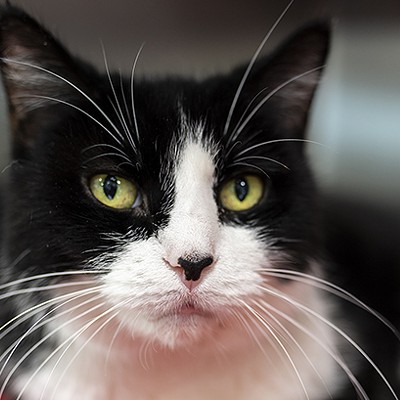But the most important thing to know about Sid is this: He was loved.
Still, love couldn't block his untimely demise on Dec. 16 at the Humane Society of Southern Arizona. This occurred despite the fact that, only hours before, Sid's owner had filed a lost-animal report with that very same shelter.
Given the fact that the local Humane Society processes approximately 17,000 animals a year--finding homes for 93 percent of them--it isn't beyond reason that mistakes can happen. Dry stats are cold comfort, though, when it's your longtime pet that winds up dead.
Caroline Palmer can tell you about that. She looked after Sid for many years, until the December day when workers let him escape from her Armory Park home.
Sid wasn't cut out for the streets. He was an inside cat, spayed and declawed. So when he turned up missing, Palmer did what any responsible pet owner should: She scooted right over to the Humane Society and filed that lost-pet report.
Meanwhile, Sid had wandered to the home of a neighbor who didn't know him, but fed and sheltered him nonetheless. The next morning, that neighbor took Sid to the Humane Society.
The story could have ended there, with a happy reunion between owner and cat. It did not.
About that time, Palmer had finished tacking up lost-pet signs around the neighborhood, one of which was spotted by the kind lady who had cared for her cat. When Palmer learned that Sid had been taken to the shelter, she felt relieved. She'd filed the paperwork ensuring that shelter workers would pluck Sid from the crowd, and all would be well.
As it turns out, shelter workers failed to check that lost-cat file when Sid arrived. And within the hour, Palmer's beloved old cat had been euthanized.
"Sure, they were really quick to reimburse me for cremation," she says, "and they told me that I could come in and get kittens at no charge. But since then, I've called and left messages about wanting to come get kittens. I've also sent e-mails a few times. But I've never heard back."
Palmer wants an apology--and a better understanding of why her cat was killed. "I think it's a little more than someone just making a mistake," she says. "Maybe Sid didn't look good, but he was 17 years old. And he had that nerve damage--he was born with it--so he always walked crooked. And he was tiny. So they looked at him, and they thought there was something really wrong with him."
But obviously, shelter staffers didn't look hard enough to learn--from their own files--that someone out there was searching for Sid.
Marsh Myers is a spokesman for the Humane Society of Southern Arizona, and he acknowledges that his staff failed to check that file. However, he says that employees handling Palmer's pet noticed numerous indicators of a little cat in big trouble. "That kitty couldn't even poop or pee on her own," he says. "We had to stimulate her like a mother does with a newborn, by taking a wet wash cloth and rubbing those areas in order to get her to express, because she didn't actually have any control over her bodily functions."
To shelter workers, it appeared that Sid had been hit by a car, or perhaps abused. "When you have animals like that," says Myers, "very often, you see a buildup of urine and a buildup of feces on the back of the body."
This tragedy is compounded considering the Humane Society's aggressive policy of reuniting lost pets with their owners. That includes the use of "pet detectives" who spend their days trying to make such reunions possible. "It's a huge part of our mission," Myers says.
Still, with all that, the system did break down. "There were a variety of things that went wrong here," Myers says. "Nobody was trying to be malicious. But we didn't know what was causing the paralysis. If it was hit by a car, which is typical, then that animal could have been in a huge amount of pain. And it was obviously suffering, regardless. So the (staff) wanted to eliminate the suffering."
Fortunately, such incidents do appear to be rare.
"These aren't the kinds of things I see coming across my desk everyday," says Kim Intino, director of animal sheltering issues for the Humane Society of the United States. And while she lauds the Tucson shelter for openly admitting its mistake, she stresses the need for ironclad protocols.
"It goes to standard operating procedures," she says. "Of course, there is going to be human error. But the thing the Humane Society of the United States stresses the most is to minimize" those kinds of mistakes.
That can be achieved by putting those policies in writing, she says, coupled with reviewing them regularly. "And one of those procedures, of course, is making decisions with regards to euthanasia. It goes hand-in-hand with stray-animal hold periods, lost-and-found issues, and identification issues such as collars and tags, scanning for microchips or anything like that."
In addition, "euthanasia procedures should contain a component of double-checking, even triple-checking, for ownership ... and having a veterinarian on hand to determine whether an animal is suffering from a neurological condition and can be held for three days, or whether it is really suffering.
"It is definitely not a black-and-white situation," Intino says. "But we do urge shelters to take every precaution before making necessary decisions."
At the Tucson shelter, where animals are generally held for no less than 72 hours, Myers says his staff is beefing up oversight to ensure that no more animals fall through the cracks. "Supervisors are checking on staff to make sure that they are following through" on safeguards. "Or if the animal has any special (medical) situations, we try to get the veterinarian over to see the animal as soon as possible. This was a very rare occurrence, and hopefully it won't occur again."But that won't bring Sid back, says Caroline Palmer. "He was old and probably wouldn't have been around that much longer, and it would have been really hard for me to put him down. But none of that really matters, because I didn't have a choice."












